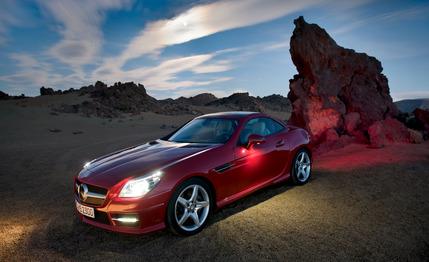 First Drive Review
First Drive Review
Ever since the Mercedes-Benz SLK launched in 1997, this small roadster has seemingly tried to fool people into thinking it’s a different car. At first glance, the original SLK appeared to be an SL. Its successor, the SLK of 2005, bore the nose of an SLR McLaren. And the face of the latest SLK has us thinking SLS. Since looks are everything to many sports-car buyers, the SLK being mistaken for a far more expensive and exotic Mercedes-Benz is about the best thing that could happen. Mistaken identity by design has worked well for Mercedes: More than 500,000 SLKs have been sold worldwide over the model’s lifetime.
It may be priced similarly to the BMW Z4, Chevrolet Corvette, and Porsche Boxster, but the SLK has always been more relaxed than those cars. It wasn’t until the last generation that the SLK’s handling and performance delivered on the promise of its looks. This latest is sportier yet, but it’s not a hard-core, elemental sports car like the Boxster. Nor does it have the brute force and superhero bravado of the Corvette. It’s most like the BMW, and although the Z4 doesn’t have much to recommend it, the new SLK does.
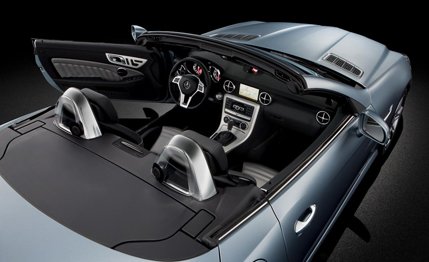
All-New V-6
For starters, the 2012 SLK has a new engine. Not a revised, warmed-over engine, but an all-new V-6 with a 60-degree angle between the cylinder banks. (The old 90-degree V-6 was derived from a V-8 design.) Not only does the new engine have an ideal angle for a V-6—a V-6 is more naturally balanced at 60 degrees—but it also leaves more room for turbochargers to sit alongside the block. Room for turbos underhood means room for a turbo version in the lineup. Whether or not that will happen remains to be seen. The inevitable AMG version would be the obvious choice for turbocharging, but when the SLK55 arrives, it will be powered by a naturally aspirated V-8.
For the time being, the top engine will be a 3.5-liter V-6. Equipped with direct fuel injection, the V-6 has a compression ratio of 12.3:1. The engine makes 302 hp at 6500 rpm and 273 lb-ft of torque at 3500. U.S. versions will get a seven-speed automatic. With the autobox, figure on a 0-to-60-mph run of about 5.5 seconds. The engine is smoother and less prone to droning vibrations than its predecessor, spinning happily and emitting a delightful intake snarl as the engine ferociously pulls past 5000 rpm on its way to the 6800-rpm shift point.
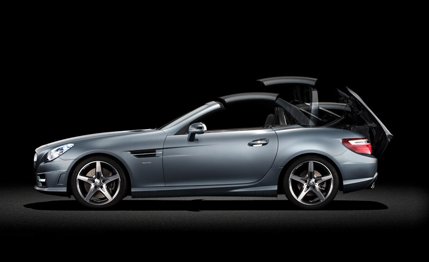
A less-powerful SLK250 will follow eight months after the launch of the SLK350 this July. The 250 will be powered by a new turbocharged 1.8-liter four-cylinder that makes 201 hp and 229 lb-ft. It initially will be available only with the corporate seven-speed automatic, but a six-speed manual will be offered with the four-cylinder at a later date. Lighter than the V-6 by a claimed 89 pounds—weight that comes primarily off the nose—the four-cylinder should greatly improve the SLK’s dynamics.
The four-cylinder may be the lightest of the U.S.-bound SLKs, but even cars with the V-6 keep their weight down by using aluminum for the fenders and hood. The available Magic Sky Control roof—which alters its opacity with the push of a button—is a whopping 110 pounds lighter than the steel cap. Raising or lowering the top takes fewer than 20 seconds, but unlike some cloth-topped competitors, the SLK has to be stopped to make the change. Overall, Mercedes says the SLK350 weighs about the same as the outgoing model, despite being longer and wider.
Is This Sportiness We Feel?
The SLK is an easy car to drive quickly. Strong brakes, plenty of grip, tight roll control, and a supportive seat take the surprise out of unfamiliar mountain roads. Turn the thick-rimmed and flat-bottomed steering wheel, and the SLK surprises with predictable turn-in and a high level of front-end grip. Like the previous model, the new car has a variable-ratio steering rack that quickens as you turn it farther from center. Mercedes calls it Direct Steer. We call it slightly numb at sedate speeds, but the steering gains weight in response to the stresses placed on the front tires. At screeching cornering speeds, there’s a Porsche-level relationship between the steering and driver, with a bit more novocaine numbness than in a Porsche. Further enhancing turn-in and corner stability are Mercedes’ torque vectoring brakes, part of the Dynamic Handling package. The system, which is similar to the one Porsche uses in the 911 Turbo, proactively clamps individual brakes to help steer the car.
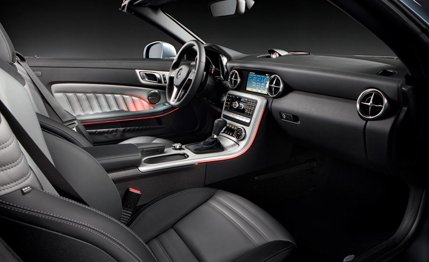
Upsetting the balanced controls and attitude of the SLK is the seven-speed transmission. Paddle shifters behind the wheel allow the driver to request upshifts and downshifts, but the car takes them as mere requests and doesn’t always comply right away. It’s frustrating to ask for a second downshift and not receive it until somewhere midcorner. The transmission also has a tendency to stumble from third into fourth at part throttle.
Still a Mercedes
As we mentioned, the SLK is a roadster that is willing to relax. At highway speeds, the engine is muted, tire noise stays in the background, and the two-seater begins to feel like the C-class on which it is based. The new interior is a welcome departure from that of the last SLK. Gone is shiny-plastic, generic switchgear; in its place is what appears to be a scale model of the SLS dashboard. The design is modern, clean, and elegant. Driver and passenger both benefit from more shoulder room, thanks to an extra 1.3 inches of width.
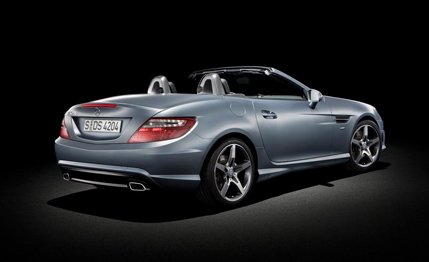
Prices are expected to start around $50,000. Eight airbags and Attention Assist (the system that tries to guess if you’re dreaming and driving) are standard. Luxurious options include the Magic Sky Control roof, an AMG appearance package, and Airscarf, which blows warm air onto your neck. Safety extras include active cruise control with collision warning. Fully loaded, the SLK350 will probably reach into the low-to-mid-$60,000 range. We expect the SLK250 to start at approximately $45,000 when it arrives next spring, with very little visual distinction from the 350. And, hey, if even one in 20 people thinks your SLK is actually an SLS, consider it a bargain.